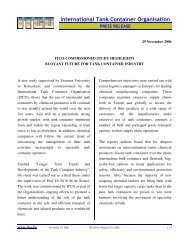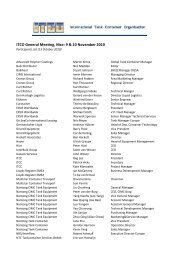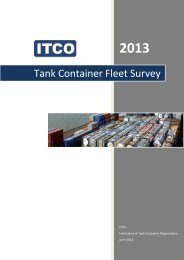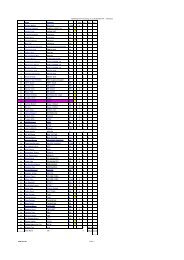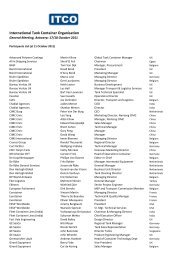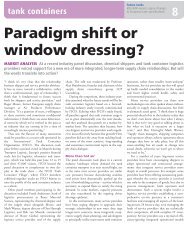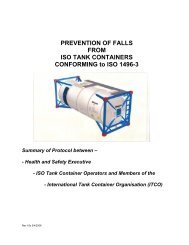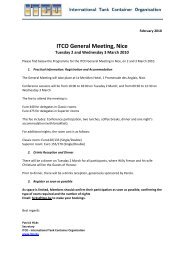You also want an ePaper? Increase the reach of your titles
YUMPU automatically turns print PDFs into web optimized ePapers that Google loves.
ICHCA International <strong>Safe</strong>ty Panel Briefing Pamphlet No 30<br />
Annex 5 Dangerous Goods<br />
A5.1 Regulations and Instructions<br />
A5.1.1 The International Maritime Dangerous Goods Code (IMDG) will be applied to<br />
all movements by sea. It is implemented by national laws. Note the IMDG<br />
Code refers to portable tanks and any reference to them applies to tank<br />
containers.<br />
ADR/RID or ADN may be the applicable regulations for road / rail or inland<br />
waterways transport within Europe.<br />
A5.1.2 Dangerous goods are assigned a class and a division. A summary can be<br />
found in the International <strong>Safe</strong>ty Panel Briefing Pamphlet No. 3 “THE<br />
INTERNATIONAL MARITIME DANGEROUS GOODS (IMDG) CODE”.<br />
Section 4 Classification lists the 9 Classes <strong>of</strong> dangerous goods and<br />
describes the primary and secondary hazards.<br />
Section 5 describes the degree <strong>of</strong> hazard (packing group).<br />
A5.1.3 <strong>Tank</strong> <strong>Containers</strong> (Portable <strong>Tank</strong>) Instructions and Special Provisions<br />
A5.1.3.1 Portable tank Instructions apply to dangerous goods <strong>of</strong> classes 1 to 9 and<br />
provide specific information relevant to portable tanks provisions<br />
applicable to specific substances.<br />
A5.1.3.2 For substances <strong>of</strong> class 1 and classes 3 to 9, the portable tank<br />
instructions indicate the applicable minimum test pressure, the minimum<br />
shell thickness (in reference steel), bottom opening provisions and<br />
pressure-relief provisions. In T23, self-reactive substances <strong>of</strong> class 4.1<br />
and class 5.2, organic peroxides permitted to be transported in portable<br />
tanks are listed along with applicable control and emergency<br />
temperatures.<br />
A5.1.3.3 Non-refrigerated liquefied gases are assigned to portable tank instruction<br />
T50. T50 provides the maximum allowable working pressures, bottom<br />
opening provisions, pressure-relief provisions and degree <strong>of</strong> filling<br />
provisions for non-refrigerated liquefied gases permitted for transport in<br />
portable tanks.<br />
A5.1.3.4 Refrigerated liquefied gases are assigned to portable tank instruction<br />
T75. Determination <strong>of</strong> the appropriate portable tank instructions<br />
A5.1.3.5 Column 13 <strong>of</strong> the Dangerous Goods List in chapter 3.2 <strong>of</strong> the IMDG Code<br />
indicates the “Instruction” that shall be used for each substance permitted<br />
for transport in a tank container. The Instruction refers to a designation<br />
identified by an alpha-numeric designation (T1 to T75). Table A5.1 is an<br />
excerpt from paragraph 4.2.5.2.6. <strong>of</strong> the IMDG Code<br />
Page 63 ©ICHCA International Limited



